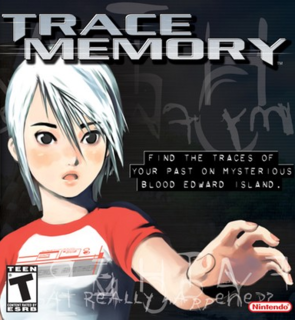The experience of playing Trace Memory may not last long, but the memory of it will stay with you for quite a while.
The game casts you as 13-year-old Ashley Mizuki Robbins, a likable girl who has been raised by her aunt Jessica and knows very little about her parents. Jessica has always led Ashley to believe that her parents were dead, so it comes as quite a shock to Ashley when she receives a package from her father containing a strange device called a DTS, which, as it turns out, bears an uncanny resemblance to a DS. As the game begins, it is the eve of Ashley's fourteenth birthday, and she is headed out to charming, picturesque Blood Edward Island, where her father has said he'll be waiting for her. She quickly learns from Jessica that her father is a scientist studying human memory, and that he designed the DTS she received specifically for her, and nobody else can use it. Beyond that, the less said about the story, the better. Suffice it to say that it involves a puzzle-filled mansion, a ghost, and an investigation into Ashley's memories and the truth of her past. Some may find a few elements a bit hard to swallow, but for the most part it's a compelling story that doles out new information at just the right pace to keep you pressing on. Trace Memory has an unusual but very effective presentational style. On the bottom screen of the DS, there's an overhead view of Ashley, and using the D-pad moves her around. On the top screen, there is a detailed static image of Ashley's surroundings. If there's anything worth investigating, a magnifying glass icon lights up, and you can bring the static image down to the lower screen and either touch or move a cursor over anything you want to examine more closely. As in many adventure games, it behooves you to look in every nook and cranny, as you never know where some vital clue or item will be hidden. In some games this kind of hunting can be exceedingly boring, but the rich detail of Trace Memory's environments, the simplicity of the interface and the game's relatively quick pacing keep things from ever degrading into tedium. An adventure game is only as good as its puzzles, and most of the puzzles in Trace Memory are very good. Most of them are not especially difficult, either, but there are a few real stumpers. However, unlike in many lesser adventure games, the puzzles all have a kind of logic to them, so when you do figure them out you're satisfied at having surpassed a challenge, not tempted to yell, "Oh, come on! How the hell was I supposed to figure that out?!" What's most impressive about the puzzles is the way that they take advantage of the DS's features. Of course, you'll use the touch screen to do all kinds of things, and the microphone to do a few other things, but a few of the best puzzles in the game implement the design of the DS in extremely creative and surprising ways.
Trace Memory is very attractive, thanks to the richly detailed images you'll spend most of the game scrutinizing. The characters, Ashley in particular, have a slightly anime look to them, but it's not overdone and helps to make them expressive, which is good considering that the story is a major part of the game. Trace Memory doesn't offer up a whole lot in the way of sound effects, but the music you hear throughout the game certainly fits in well with the overall mood and tone of the adventure.
This is not a long game at all. Depending on how long the game's tougher puzzles hold you up, you could reasonably spend anywhere from about five to nine hours the first time through, and after that, if you wanted to play through it again for some reason, you could probably do so in well under four hours. However, what Trace Memory lacks in duration, it makes up for in quality. Fans of adventure games will find this innovative game well worth their while. The experience of playing Trace Memory may not last long, but the memory of it will stay with you for quite a while.

